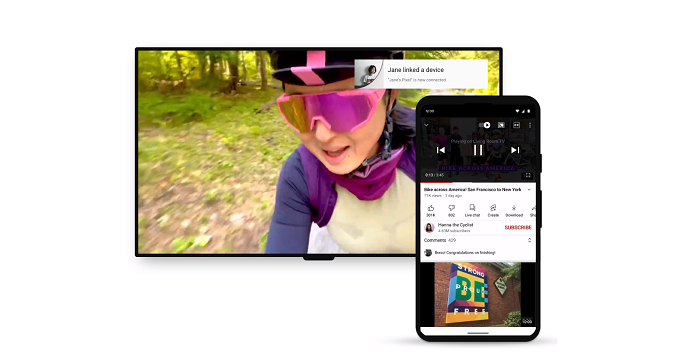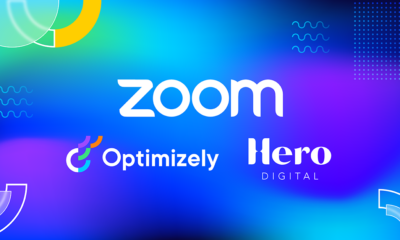SOCIAL
YouTube Launches New Process to Connect Your Mobile Device with Your TV Viewing Experience

For years, social platforms have been trying to work out how to maximize ‘second screening, or the use of mobile devices while watching content on your main TV screen at home.
Twitter tried to integrate tweets into the display, in order to capitalize on its leadership as a key destination for live event discussion, while Facebook has also sought to build new options that integrate live events and in-app usage.
Maybe, now, YouTube has actually worked out the best way to do it.
As you can see in the above example, YouTube’s rolling out a new feature that will enable users to connect their TV viewing experience to their mobile device, so that you can watch content on the big screen, while exploring video comments, recommendations and more from your mobile app.
As explained by YouTube:
“Now your phone will be synchronized to the TV, so you can directly interact with the video you are watching from the convenience of your phone. That means it’s easier than ever to read video descriptions, leave comments, share the video with a friend, or support your favorite creators by sending a Super Chat or becoming a member, all while you watch on the big screen.”
It’s an interesting, though again, not entirely new concept. You’ve been able to conduct similar on your mobile device for some time, though most people are generally looking to scan through other apps and platforms while viewing content on TV, as opposed to using their phone as an extension of their main screen experience.
But still, with over 135 million people now consuming YouTube content on their home TV screens, that does open up new opportunity, and it may well be that by essentially converting your phone into a YouTube specific remote control, and facilitating advanced engagement, that could drive more interaction with YouTube content.
And you can test it out yourself, right now:
“To try this, your phone and TV must be signed in to the same YouTube account. Open the YouTube app on TV, then open the YouTube app on your phone, and click “Connect” on the prompt that automatically pops up.”
Again, it may not be the ultimate solution that finally bridges the traditional and new forms of media consumption, and maximizes in-app engagement. But it’s an interesting shift, aligned with new viewing behaviors.
And that’s not all:
“We’re already starting to test new designs for our video watch page to help fold in more uniquely YouTube features – such as browsing and shopping for products featured in videos – directly to the big screen to help you decide when to pick up your phone and engage.”

Streamlined eCommerce based on your TV viewing behavior could drive more purchase activity, and change the way that people use the YouTube app.
It still feels like most people won’t adopt this process, as again, they’re generally browsing in other apps to find out, say, what other things an actor has been in, what people are saying about it on Twitter, and what else is happening in other apps.
But it’s an interesting experiment either way, and if YouTube can improve its product display listings and ads, and make users want to engage more via the app, that could lead to new engagement behaviors.
It’s a worthy experiment either way, leaning into the increasing use of YouTube on home TV sets.
You can read more about YouTube’s new TV integration process here.
SOCIAL
Snapchat Explores New Messaging Retention Feature: A Game-Changer or Risky Move?

In a recent announcement, Snapchat revealed a groundbreaking update that challenges its traditional design ethos. The platform is experimenting with an option that allows users to defy the 24-hour auto-delete rule, a feature synonymous with Snapchat’s ephemeral messaging model.
The proposed change aims to introduce a “Never delete” option in messaging retention settings, aligning Snapchat more closely with conventional messaging apps. While this move may blur Snapchat’s distinctive selling point, Snap appears convinced of its necessity.
According to Snap, the decision stems from user feedback and a commitment to innovation based on user needs. The company aims to provide greater flexibility and control over conversations, catering to the preferences of its community.
Currently undergoing trials in select markets, the new feature empowers users to adjust retention settings on a conversation-by-conversation basis. Flexibility remains paramount, with participants able to modify settings within chats and receive in-chat notifications to ensure transparency.
Snapchat underscores that the default auto-delete feature will persist, reinforcing its design philosophy centered on ephemerality. However, with the app gaining traction as a primary messaging platform, the option offers users a means to preserve longer chat histories.
The update marks a pivotal moment for Snapchat, renowned for its disappearing message premise, especially popular among younger demographics. Retaining this focus has been pivotal to Snapchat’s identity, but the shift suggests a broader strategy aimed at diversifying its user base.
This strategy may appeal particularly to older demographics, potentially extending Snapchat’s relevance as users age. By emulating features of conventional messaging platforms, Snapchat seeks to enhance its appeal and broaden its reach.
Yet, the introduction of message retention poses questions about Snapchat’s uniqueness. While addressing user demands, the risk of diluting Snapchat’s distinctiveness looms large.
As Snapchat ventures into uncharted territory, the outcome of this experiment remains uncertain. Will message retention propel Snapchat to new heights, or will it compromise the platform’s uniqueness?
Only time will tell.
SOCIAL
Catering to specific audience boosts your business, says accountant turned coach

While it is tempting to try to appeal to a broad audience, the founder of alcohol-free coaching service Just the Tonic, Sandra Parker, believes the best thing you can do for your business is focus on your niche. Here’s how she did just that.
When running a business, reaching out to as many clients as possible can be tempting. But it also risks making your marketing “too generic,” warns Sandra Parker, the founder of Just The Tonic Coaching.
“From the very start of my business, I knew exactly who I could help and who I couldn’t,” Parker told My Biggest Lessons.
Parker struggled with alcohol dependence as a young professional. Today, her business targets high-achieving individuals who face challenges similar to those she had early in her career.
“I understand their frustrations, I understand their fears, and I understand their coping mechanisms and the stories they’re telling themselves,” Parker said. “Because of that, I’m able to market very effectively, to speak in a language that they understand, and am able to reach them.”Â
“I believe that it’s really important that you know exactly who your customer or your client is, and you target them, and you resist the temptation to make your marketing too generic to try and reach everyone,” she explained.
“If you speak specifically to your target clients, you will reach them, and I believe that’s the way that you’re going to be more successful.
Watch the video for more of Sandra Parker’s biggest lessons.
SOCIAL
Instagram Tests Live-Stream Games to Enhance Engagement

Instagram’s testing out some new options to help spice up your live-streams in the app, with some live broadcasters now able to select a game that they can play with viewers in-stream.
As you can see in these example screens, posted by Ahmed Ghanem, some creators now have the option to play either “This or That”, a question and answer prompt that you can share with your viewers, or “Trivia”, to generate more engagement within your IG live-streams.
That could be a simple way to spark more conversation and interaction, which could then lead into further engagement opportunities from your live audience.
Meta’s been exploring more ways to make live-streaming a bigger consideration for IG creators, with a view to live-streams potentially catching on with more users.
That includes the gradual expansion of its “Stars” live-stream donation program, giving more creators in more regions a means to accept donations from live-stream viewers, while back in December, Instagram also added some new options to make it easier to go live using third-party tools via desktop PCs.
Live streaming has been a major shift in China, where shopping live-streams, in particular, have led to massive opportunities for streaming platforms. They haven’t caught on in the same way in Western regions, but as TikTok and YouTube look to push live-stream adoption, there is still a chance that they will become a much bigger element in future.
Which is why IG is also trying to stay in touch, and add more ways for its creators to engage via streams. Live-stream games is another element within this, which could make this a better community-building, and potentially sales-driving option.
We’ve asked Instagram for more information on this test, and we’ll update this post if/when we hear back.
-
SEARCHENGINES7 days ago
Daily Search Forum Recap: April 19, 2024
-

 WORDPRESS6 days ago
WORDPRESS6 days ago13 Best HubSpot Alternatives for 2024 (Free + Paid)
-

 MARKETING6 days ago
MARKETING6 days agoBattling for Attention in the 2024 Election Year Media Frenzy
-

 WORDPRESS6 days ago
WORDPRESS6 days ago7 Best WooCommerce Points and Rewards Plugins (Free & Paid)
-

 MARKETING5 days ago
MARKETING5 days agoAdvertising in local markets: A playbook for success
-

 SEO7 days ago
SEO7 days agoGoogle Answers Whether Having Two Sites Affects Rankings
-

 SEARCHENGINES6 days ago
SEARCHENGINES6 days agoGoogle Core Update Flux, AdSense Ad Intent, California Link Tax & More
-

 AFFILIATE MARKETING6 days ago
AFFILIATE MARKETING6 days agoGrab Microsoft Project Professional 2021 for $20 During This Flash Sale


![The Current State of Google’s Search Generative Experience [What It Means for SEO in 2024] person typing on laptop with](https://articles.entireweb.com/wp-content/uploads/2024/04/The-Current-State-of-Googles-Search-Generative-Experience-What-It.webp-400x240.webp)
![The Current State of Google’s Search Generative Experience [What It Means for SEO in 2024] person typing on laptop with](https://articles.entireweb.com/wp-content/uploads/2024/04/The-Current-State-of-Googles-Search-Generative-Experience-What-It.webp-80x80.webp)












You must be logged in to post a comment Login